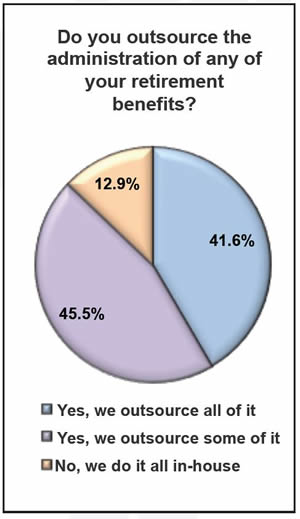- 86.6% of the employers responding to our 2014 survey offer either a 401(k) or 403(b) retirement savings plan to employees.
- 60.3% of the employers responding to our survey that offer a 401(k) or 403(b) plan to their employees also provide a matching contribution.
- 41.4% of employers match employee contributions dollar-for-dollar. 31.3% go 50 cents on the dollar.
- Other retirement benefits offered by our survey participants include: defined benefit plans (23.7%), Roth 401(k) (33.2%), 457 plan (13%), profit sharing (22.7%), stock options (3.9%), employee stock ownership plan (7.2%), union-sponsored pension plan (2.6%), and/or SIMPLE or SEP (4.3%).
401(k) or 403(b)
Offering either a 401(k) or 403(b) retirement savings plan to employees is a best practice for many U.S. employers. In fact, 86.6% of the employers responding to our 2014 survey offer one of these plans. Only 39.9% (compared to 33% in 2013) of those who answered the question, however, automatically enroll employees, though 2.3% (compared to 2.5% in 2013) plan to implement auto-enrollment in the future.
Employee Contributions
When the employee enrollment in defined contribution plans is automatic, the percent of employee earnings initially contributed is less than 3%, for 23.3% (compared to 27% in 2013) of the employers that responded to this question in our survey. It is 3% for 42.7% and 4% of employee earnings for 9.7%. The employee contribution is 5% of earnings for 8.3% and 6% of earnings for 9.7%. More than 6% of employee earnings are contributed for 6.2% of survey participants.
For 22.2% of survey participants, the level of voluntary participation in their 401(k) or 403(b) plans is less than 30% of employees. For 37.6%, voluntary participation is 31% to 70% of employees and, for 40.2%, voluntary participation is above 70% of employees.
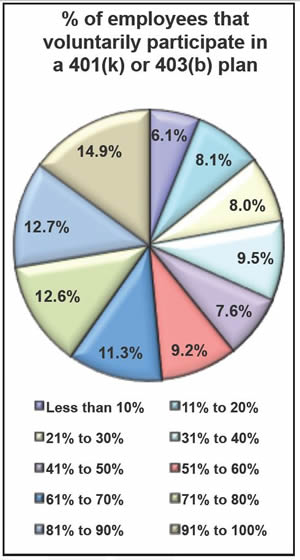
The percentage of their earnings that employees begin with when contributing to voluntary 401(k) or 403(b) plans is less than 3% of base salary for 23.3% of our survey participants. It’s 3% of earnings for 29.3% and 4% of salary for 14.5%. Responses to our survey show that employees begin their contributions at a rate of 5% of their base salary for 15.9% of employers, at 6% of salary for 12.2%, and over 6% of earnings for 4.8% of employers.
The practice of employees adding the “cash-out” for their unused vacation or sick time to their 401(k) or 403(b) plans is permitted by 6.3% of employers, and 4.1% are considering whether to allow it.
The maximum amount employees may contribute annually to their 401(k) or 403(b) plan for 95.3% of employers is the highest amount allowed by the IRS, which is $17,500 for 2014.
Employer Matching
Though 18.7% have never provided an employer match, the majority (60.3%) of the employers responding to our survey that offer a 401(k) or 403(b) plan to their employees also provide a matching contribution. Though 4.4% temporarily stopped their employer match in recent years, 13.1% maintained their matching contributions throughout the recent recession.
The level of employers’ matching contributions is as high as 6% of employee earnings for 23.9% of employers, up to 5% for 14.7%, and up to 3% for 14.9% of employers. Up to 10% is the level for 3% of employers and 3.4% of survey participants match more than 10% of employee earnings.
Matching employee contributions dollar-for-dollar is the practice for 41.4% of employers. A match rate of 75 cents to the dollar is the norm for 2.4%, 50 cents on the dollar is provided by 31.3%, and 25 cents per dollar of employee contribution is standard for 9.4% of employers.
Compensation.BLR.com, now thoroughly revved with easier navigation and more complete compensation information, will tell you what’s being paid right in your state–or even metropolitan area–for hundreds of jobs. Try it at no cost and get a complimentary special report. Read More.
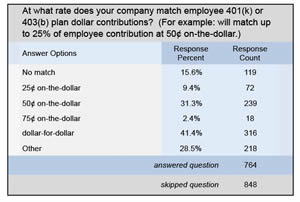
The requirement for vesting of employer contributions is 5 years of service for 23.8% of employers and 12.5% require more than 5 years. Less than a year of service is required by 25.6% of employers, 1 year is required by 16.5%, 2 years is the rule for 4.9%, 3 years is required by 13.3%, and 4 years is the vesting level for 3.4% of employers.
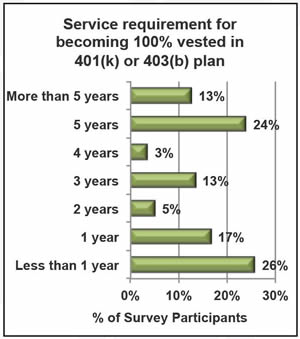
Plan Features
More than 15 investment options are offered by 50.7% of employers and 11 to 15 options are offered by 27.7%. Another 13.4% offer 6 to 10 investment options and 8.2% of employers in our survey offer 1 to 5 options.
Target Date/Life Cycle funds are available for 67.7% of survey participants. The in-plan Roth conversion, a feature made available by the Small Business Jobs Act of 2010, is available for 28.2% and 3.4% are planning to add the feature.
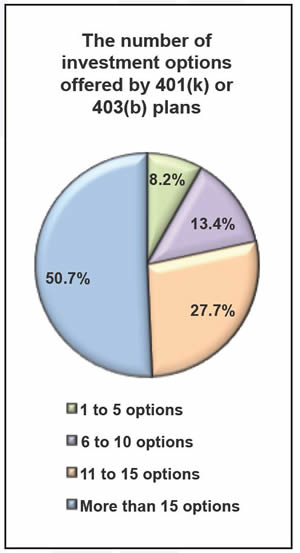
Other Retirement Benefits
Other retirement benefits offered by our survey participants include defined benefit plans (23.7%), Roth 401(k) (33.2%), 457 plan (13%), profit sharing (22.7%), stock options (3.9%), employee stock ownership plan (7.2%), union-sponsored pension plan (2.6%), and/or SIMPLE or SEP (4.3%).
Try BLR’s all-in-one compensation website, Compensation.BLR.com®, and get a complimentary special report, Top 100 FLSA Overtime Q&As, no matter what you decide. Find out more.
Benefits Planning and Administration
Retirement benefits in 2014 are about the same as 2013 for 86.7% of survey participants and more generous for 7%. It’s been 4 years or more since 26.9% of our survey participants conducted a comprehensive review of their retirement benefits package. A thorough review was conducted in 2013, however, by 43.6% and in 2012 by 15.5%.
When it comes to determining which retirement benefits to offer, 39.9% work with a consultant to create their plans and 35.2% evaluate the benefits offered by other companies and their competitors. An employee survey to find out what employees have an interest in is conducted by 9.7% and 41.9% are guided by the cost to the company.
Retirement benefits are managed in-house by 12.9% of those who responded to this question in our survey. Some of the administration of benefits is outsourced by 45.5% and all administration is outsourced by 41.6%.
In tomorrow’s Advisor, more survey results, plus an introduction to the all-things-compensation-in-one-place website, Compensation.BLR.com.
